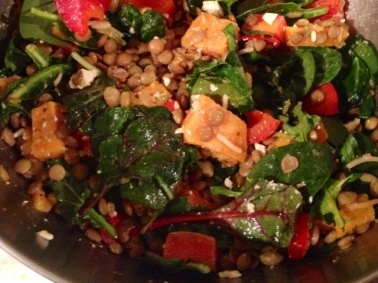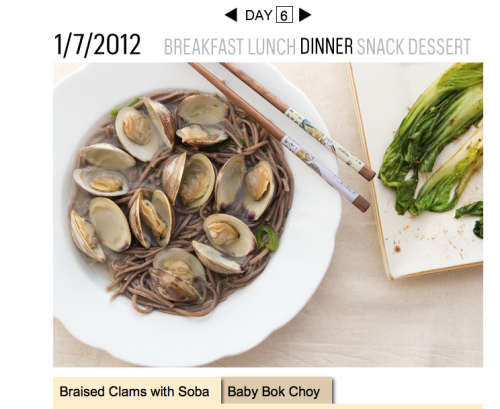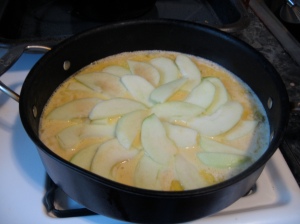
My recipes, or ideas for recipes, tend to be sourced from a steady revolving door of reliable standbys. My mom’s cooking and whatever I can piece together from childhood memories is one; Epicurious and other standby blogs are another. Then, of course there’s the steady block of cookbooks on my kitchen windowsill: silent, sturdy, dogeared friends that feel enormously welcoming in an age where recipe-writing needs to be catered to mobile apps.
I’m not vegetarian, but I have a tendency to lean towards it, mostly because I was raised on a lot of South Indian food (a diet that’s inherently meat free but remains, in my opinion, one of the most complex and delicious cuisines in the world.) Plenty is a great book for people like myself- for those who tend to splurge more on the items in their spice cabinet than on an expensive cut of meat. And I can’t help but like that a vegetarian tome such as this one was written by a guy who not only presents his food without agenda, but suggests that one of his dishes would go great alongside some lamb. In the hyper-political, morally grandstanding environment we all live, eat and cook in, I find his approach enormously refreshing.
The New York Times, The Guardian and Epicurious have all rushed to put this on their best-of 2011 cookbook list, so what I’m saying here is not anything new. The book is beautiful both in construction and layout, and is organized, quite intelligently, by vegetable. I’m behind any book that has a chapter called “The Mighty Eggplant”.
But let’s face it – it’s the holiday season. Along with everyone else, I too am eyeing the ginger-glazed ribs and macaroons recipes, but how refreshing and festive would the eggplant dish be, the one photographed above? Ottolenghi has you roast halved eggplants with their skins on, make a simple garlic, buttermilk dressing and then dress the dish with an inspired garnish of pomegranate seeds and lemon thyme. Serve family style with some thin toasts, and you have, I think, a perfectly elegant starter to your holiday meal.
This book does have its detractors, and their criticisms are not without merit. The recipes aren’t perfect and not a few of them should be adjusted to personal taste. There are some technical mistakes (most notably perhaps, when it says to roast eggplant at 200 degrees, instead of 400 degrees – be sure to ignore that and stick to 400). My William-Sonoma Baking book, in comparison, is a technically perfect recipe book. These are recipes I know I don’t have to adjust at all – they have been tried and perfected countless times in their excellent test kitchens. Plenty is not this kind of book. But I’m endorsing it because it opens my mind to new ways of approaching vegetables. It’s a book, much like David Tanis’s Platter of Figs (which has a disastrous spinach cake recipe), that inspires rather than instructs. These are books that make me want to cook more thoughtfully, shop more carefully, and celebrate more often. Tanis and Ottole write cookbooks that keep the argument for writing cookbooks alive – there’s a narrative and a life viewpoint that aligns the pages. For cooks who are comfortable enough to adjust and recognize personal preference among the listed ingredients, this book is an excellent addition to the library.
Take the Saffron Tagliatelle with spiced butter. Sounds fussy, especially since it includes instruction on how to make your own homemade pasta. But all you need to do is the following: add a pinch of saffron to your pasta water, and cook al dente some good quality dried pasta. Raid your spice cabinet (you’ll need all your warming spices, like paprika, cinnamon, turmeric and coriander) and brown them with butter. Season with salt and pepper. That’s it – this is your sauce. Pour your butter sauce, with a handful of fresh herbs for good measure, with your cooked pasta and you have a perfect, simple first course for a dinner party.
There are some standard pairings: a watermelon and feta salad that I’ve seen countless times, a mushroom and polenta dish that I’ve relied on, with my own spin, for years – but sometimes a gentle reminder of what already works can be productive, too.
I wasn’t sure which of his many recipes to share, and I ended up choosing one that’s as un-Christmassy as possible. For as much as I’d like to pretend that I can spend my December in a permanent holiday haze of peppermint candies and egg nog, I still have a lunch to pack each day, preferably something that’s healthy and light enough to counteract all the cookies, pies and general happiness-inducing indulgence. There’s nothing virtuous about it – I’m listening to Christmas music as I type this and wishing someone could magically furnish me with some toffee pudding. But when you want to pull the reigns on a little, this cold noodle salad with a zingy sesame dressing and sweet chunks of mango is a comprise that doesn’t feel too comprising.
Soba Noodles with Eggplant and Mango
from the cookbook PLENTY, recipes by Yotam Ottolenghi
Feel free to play around this. Cubed fried tofu, as Ottolenghi suggests, would give it a protein boost.
1/2 cup rice vinegar
3 tbsp sugar
1/2 tsp salt
2 garlic cloves, crushed
1/2 to 1 red chile, finely chopped, depending on your heat preference
1 tsp toasted sesame oil
grated zest and juice of 1 lime
sunflower or canola oil
2 eggplants, cut into 3/4-inch dice
8 to 9 oz soba noodles
1 large ripe mango, cut into 3/8-inch dice or into 1/4 inch thick strips
1 1/2 cups basil leaves (use Thai basil if you can find it, but less)
cilantro leaves
1/2 red onion, very thinly sliced
In a small saucepan gently warm the vinegar, sugar and salt for up to a minute, just until the sugar dissolves. Remove from the heat and add the garlic, chile and sesame oil. Allow to cool, then add the lime zest and juice.
Heat up your canola or sunflower oil (about 1/2 a cup will do) and shallow-fry the eggplant in 3-4 batches. (Note: I like to add a bit of sugar when frying eggplant – it helps to caramelize it.) Once golden brown remove to a colander, sprinkle liberally with salt and leave there to drain.
Cook the noodles in plenty of boiling salted water, stirring occasionally, about 5-8 minutes until al dente. Drain and shake off as much as excss water as possible, and then leave to dry on a dish towel.
In a mixing bowl toss the noddles with the dressing, mango, eggplant, half of the herbs and the onion. Leave aside for 1 to 2 hours. Serve with the remaining herbs.
















